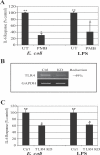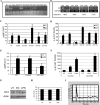A novel TLR4-mediated signaling pathway leading to IL-6 responses in human bladder epithelial cells
- PMID: 17465679
- PMCID: PMC1857715
- DOI: 10.1371/journal.ppat.0030060
A novel TLR4-mediated signaling pathway leading to IL-6 responses in human bladder epithelial cells
Abstract
The vigorous cytokine response of immune cells to Gram-negative bacteria is primarily mediated by a recognition molecule, Toll-like receptor 4 (TLR4), which recognizes lipopolysaccharide (LPS) and initiates a series of intracellular NF-kappaB-associated signaling events. Recently, bladder epithelial cells (BECs) were reported to express TLR4 and to evoke a vigorous cytokine response upon exposure to LPS. We examined intracellular signaling events in human BECs leading to the production of IL-6, a major urinary cytokine, following activation by Escherichia coli and isolated LPS. We observed that in addition to the classical NF-kappaB-associated pathway, TLR4 triggers a distinct and more rapid signaling response involving, sequentially, Ca(2+), adenylyl cyclase 3-generated cAMP, and a transcriptional factor, cAMP response element-binding protein. This capacity of BECs to mobilize secondary messengers and evoke a more rapid IL-6 response might be critical in their role as first responders to microbial challenge in the urinary tract.
Conflict of interest statement
Figures








Similar articles
-
Bacterial invasion augments epithelial cytokine responses to Escherichia coli through a lipopolysaccharide-dependent mechanism.J Immunol. 2001 Jan 15;166(2):1148-55. doi: 10.4049/jimmunol.166.2.1148. J Immunol. 2001. PMID: 11145696
-
TLR4-mediated expulsion of bacteria from infected bladder epithelial cells.Proc Natl Acad Sci U S A. 2009 Sep 1;106(35):14966-71. doi: 10.1073/pnas.0900527106. Epub 2009 Aug 17. Proc Natl Acad Sci U S A. 2009. PMID: 19706440 Free PMC article.
-
Lactobacillus rhamnosus GR-1 enhances NF-kappaB activation in Escherichia coli-stimulated urinary bladder cells through TLR4.BMC Microbiol. 2012 Jan 22;12:15. doi: 10.1186/1471-2180-12-15. BMC Microbiol. 2012. PMID: 22264349 Free PMC article.
-
Renal collecting duct epithelial cells react to pyelonephritis-associated Escherichia coli by activating distinct TLR4-dependent and -independent inflammatory pathways.J Immunol. 2006 Oct 1;177(7):4773-84. doi: 10.4049/jimmunol.177.7.4773. J Immunol. 2006. PMID: 16982918
-
Innate and adaptive immune responses in the urinary tract.Eur J Clin Invest. 2008 Oct;38 Suppl 2:21-8. doi: 10.1111/j.1365-2362.2008.02005.x. Eur J Clin Invest. 2008. PMID: 18826478 Review.
Cited by
-
TLR4 signaling and macrophage inflammatory responses are dampened by GIV/Girdin.Proc Natl Acad Sci U S A. 2020 Oct 27;117(43):26895-26906. doi: 10.1073/pnas.2011667117. Epub 2020 Oct 14. Proc Natl Acad Sci U S A. 2020. PMID: 33055214 Free PMC article.
-
A Dynamic Interplay of Innate Immune Responses During Urinary Tract Infection.Immune Netw. 2024 Jul 22;24(4):e31. doi: 10.4110/in.2024.24.e31. eCollection 2024 Aug. Immune Netw. 2024. PMID: 39246616 Free PMC article. Review.
-
Host-pathogen checkpoints and population bottlenecks in persistent and intracellular uropathogenic Escherichia coli bladder infection.FEMS Microbiol Rev. 2012 May;36(3):616-48. doi: 10.1111/j.1574-6976.2012.00339.x. FEMS Microbiol Rev. 2012. PMID: 22404313 Free PMC article. Review.
-
The role of Toll-like receptors in renal diseases.Nat Rev Nephrol. 2010 Apr;6(4):224-35. doi: 10.1038/nrneph.2010.16. Epub 2010 Feb 23. Nat Rev Nephrol. 2010. PMID: 20177402 Review.
-
Antibiotic treatment of Chlamydia-induced cystitis in the koala is linked to expression of key inflammatory genes in reactive oxygen pathways.PLoS One. 2019 Aug 15;14(8):e0221109. doi: 10.1371/journal.pone.0221109. eCollection 2019. PLoS One. 2019. PMID: 31415633 Free PMC article.
References
-
- Akira S, Uematsu S, Takeuchi O. Pathogen recognition and innate immunity. Cell. 2006;124:783–801. - PubMed
-
- Kawai T, Akira S. TLR signaling. Cell Death Differ. 2006;13:816–825. - PubMed
-
- Haraoka M, Hang L, Frendeus B, Godaly G, Burdick M, et al. Neutrophil recruitment and resistance to urinary tract infection. J Infect Dis. 1999;180:1220–1229. - PubMed
Publication types
MeSH terms
Substances
Grants and funding
LinkOut - more resources
Full Text Sources
Other Literature Sources
Medical
Miscellaneous

